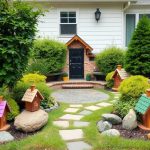Desert landscaping is a fantastic way to create a stunning front yard that thrives in dry climates. This guide showcases over 25 ideas that blend beauty and practicality, featuring drought-resistant plants, unique hardscaping options, and sustainable designs. Your front yard can be a welcoming and low-maintenance space, perfect for enjoying the desert’s natural charm.
Cacti as Focal Points
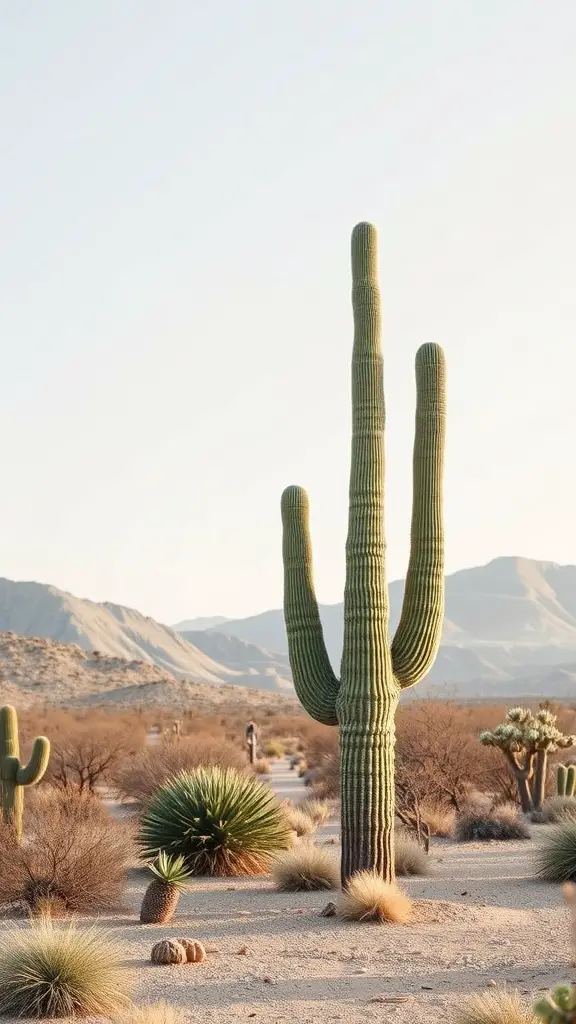
Cacti can really steal the show in desert landscaping. Their unique shapes and sizes create a striking visual impact. In the image, a tall saguaro cactus stands proudly, surrounded by smaller plants and desert scenery. This kind of arrangement draws the eye and adds depth to the yard.
Using cacti as focal points is a smart choice for front yards. They require little water and thrive in sunny spots. This makes them perfect for low-maintenance landscaping. Plus, their interesting forms can complement other plants, like the round agave seen nearby.
When planning your landscape, think about varying the heights and types of cacti. This adds layers and keeps the design dynamic. A tall cactus can serve as a centerpiece, while shorter ones can fill in the space around it. This creates a balanced look that feels both natural and curated.
Colorful Desert Flowers
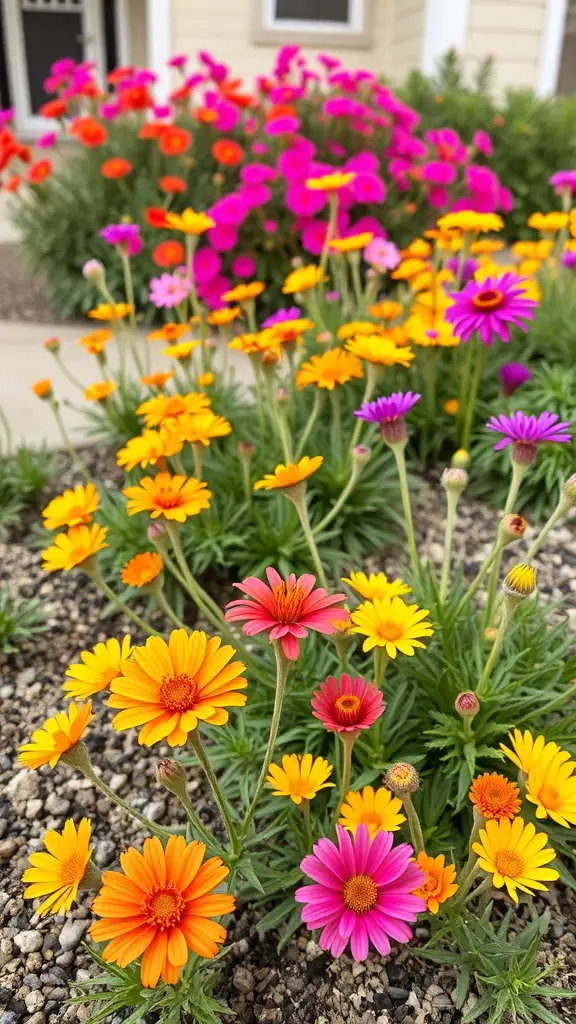
Desert landscaping can be a canvas for vibrant colors, especially when it comes to flowers. The image showcases a delightful mix of colorful desert flowers that brighten up any front yard. The bright yellows, pinks, and oranges create a cheerful atmosphere, making the space inviting.
These flowers are not just pretty; they are also well-suited for arid climates. They require less water and can thrive in sandy soil. This makes them perfect for those looking to add beauty without the hassle of high maintenance.
Incorporating such flowers into your yard can transform it into a lively space. Imagine stepping out and being greeted by a burst of color. It’s a simple way to enhance curb appeal and enjoy nature right at your doorstep.
Xeriscaping Principles
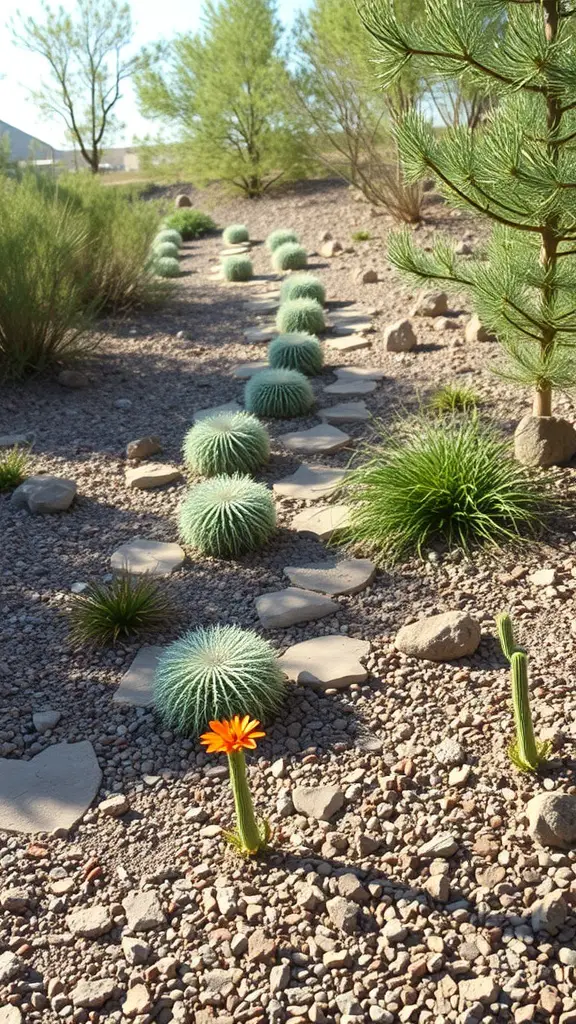
Xeriscaping is a smart approach to landscaping, especially in dry areas. The image shows a beautiful front yard designed with this principle in mind. Notice the variety of plants, including cacti and grasses, that thrive in low-water conditions.
One key aspect of xeriscaping is using native plants. These plants are adapted to the local climate and require less maintenance. In the image, the round green plants and the tall cactus are perfect examples. They not only look great but also help conserve water.
Another principle is grouping plants with similar water needs together. This makes it easier to care for them and reduces water waste. The layout in the image shows a thoughtful arrangement of plants and stones, creating a path that guides the eye while being practical.
Lastly, xeriscaping often incorporates hardscaping elements, like the stone path seen here. These features add texture and interest to the landscape while minimizing the need for grass, which typically requires more water.
Succulent Garden Designs
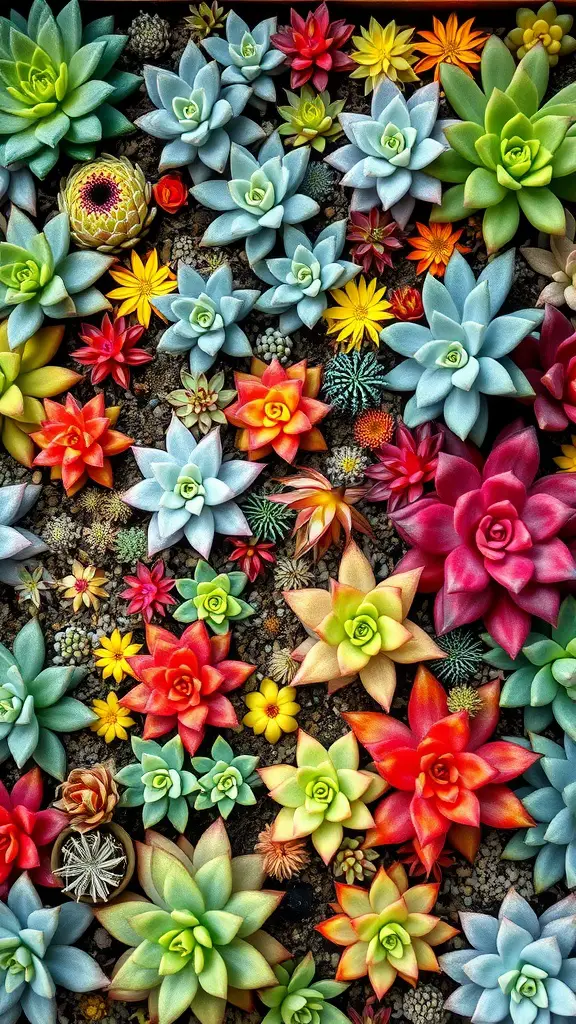
Succulent gardens are a fantastic way to add color and texture to your front yard. The image showcases a vibrant array of succulents, each bringing its own unique shape and hue. From deep greens to bright reds and yellows, these plants create a lively scene that captures attention.
These hardy plants thrive in dry conditions, making them perfect for desert landscaping. They require minimal water and care, which is a big plus for busy homeowners. The variety of sizes and colors allows for endless design possibilities, whether you prefer a structured layout or a more organic feel.
Incorporating succulents into your garden can also promote biodiversity. They attract pollinators like bees and butterflies, adding life to your outdoor space. Plus, they can be paired with decorative stones or gravel for a modern touch.
Overall, a succulent garden is not just beautiful; it’s practical too. It’s an easy way to enhance your front yard while embracing the natural beauty of desert landscapes.
Rock and Gravel Pathways
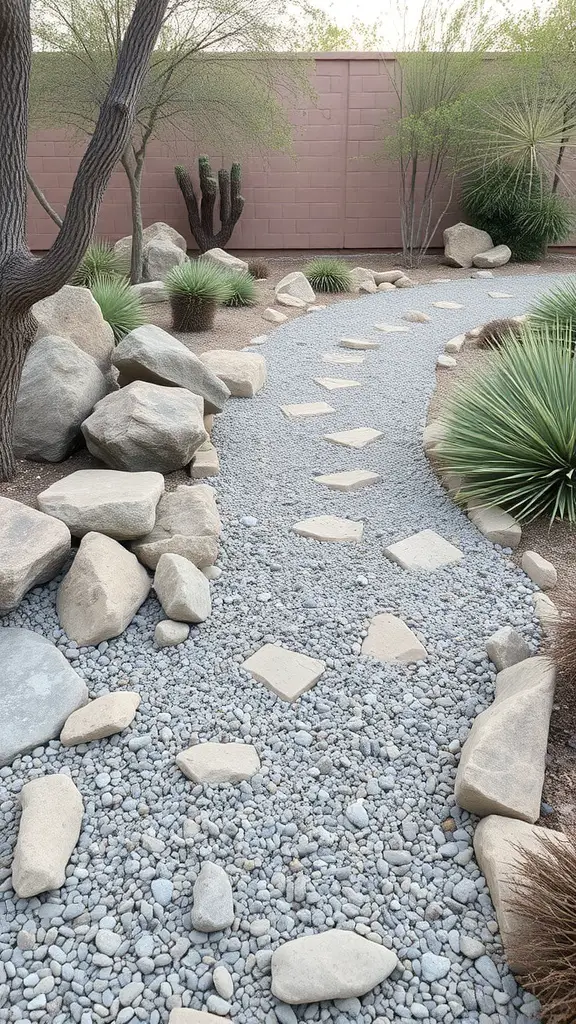
Rock and gravel pathways are a fantastic choice for desert landscaping. They add a natural feel to your front yard while being low maintenance. The image shows a charming pathway made of smooth gravel and stepping stones, winding through a desert garden.
The pathway is bordered by various plants, including succulents and small shrubs, which thrive in arid conditions. This combination creates a beautiful contrast against the soft, gray gravel. The larger rocks scattered along the path enhance the rugged look, giving it a more organic vibe.
Using gravel and rocks not only helps with drainage but also reduces the need for watering. This makes it an eco-friendly option for those looking to conserve water. Plus, it’s easy to customize the layout to fit your space, allowing for creativity in your landscaping.
Desert Hardscape Elements
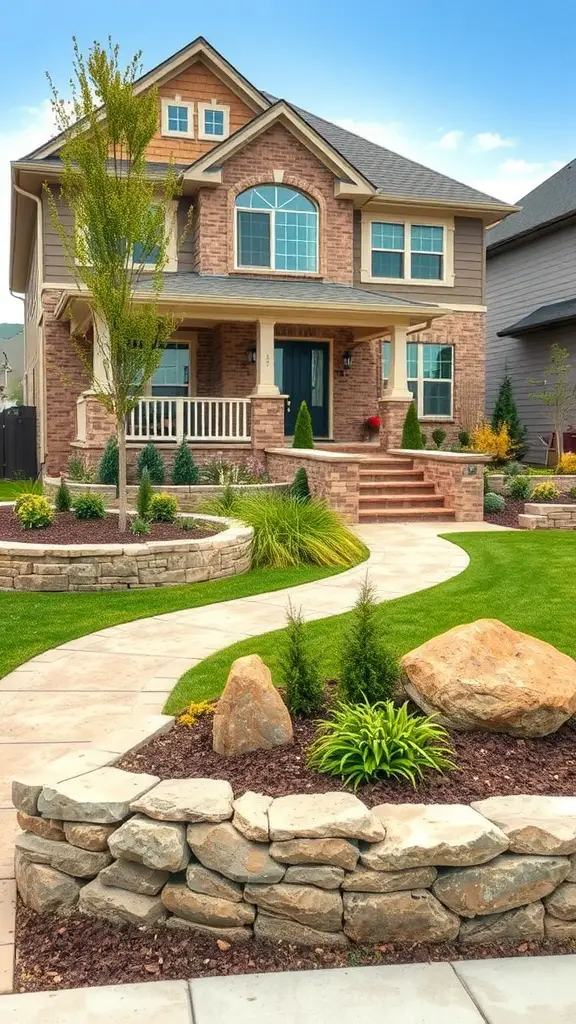
When it comes to desert landscaping, hardscape elements play a key role in creating a stunning front yard. The image showcases a beautiful home with a well-designed landscape that features a mix of stone and greenery.
The stone wall in the foreground adds texture and structure to the yard. It not only serves as a decorative element but also helps with soil retention. This is especially important in desert environments where water conservation is crucial.
The winding pathway made of concrete leads visitors to the front door, inviting them in with its gentle curves. This design not only enhances the aesthetic appeal but also provides a practical way to navigate the yard.
Incorporating natural stones and plants that thrive in arid conditions creates a balanced look. The greenery, like the small shrubs and ornamental grasses, complements the hardscape while requiring minimal water. This approach is perfect for homeowners looking to maintain a beautiful yard without excessive upkeep.
Overall, the combination of hardscape and softscape elements in this front yard exemplifies how to achieve a desert landscape that is both functional and visually appealing.
Desert-Friendly Plant Choices
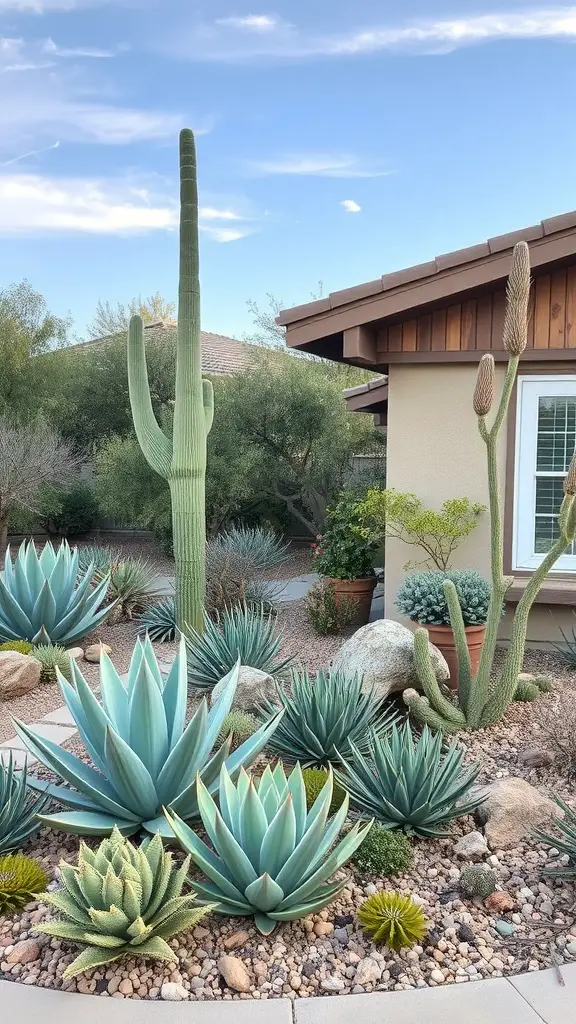
When it comes to desert landscaping, choosing the right plants is key. The image showcases a stunning array of desert-friendly plants that thrive in arid conditions. Notice the tall saguaro cactus standing proudly, a true symbol of the desert. Its unique shape adds height and character to the front yard.
Surrounding the saguaro are various agave plants, known for their striking blue-green leaves. These plants not only look great, but they also require minimal water, making them perfect for desert environments. The combination of textures and colors creates a visually appealing landscape.
In addition to cacti and agaves, the image features smaller succulents and rocks that enhance the natural feel of the space. Using gravel or rocks as ground cover helps with drainage and reduces water loss. This practical approach keeps the yard looking neat while supporting the plants’ needs.
Overall, this front yard design highlights how beautiful and functional desert landscaping can be. With the right plant choices, you can create a stunning outdoor space that thrives in the heat.
Drought-Resistant Ground Covers
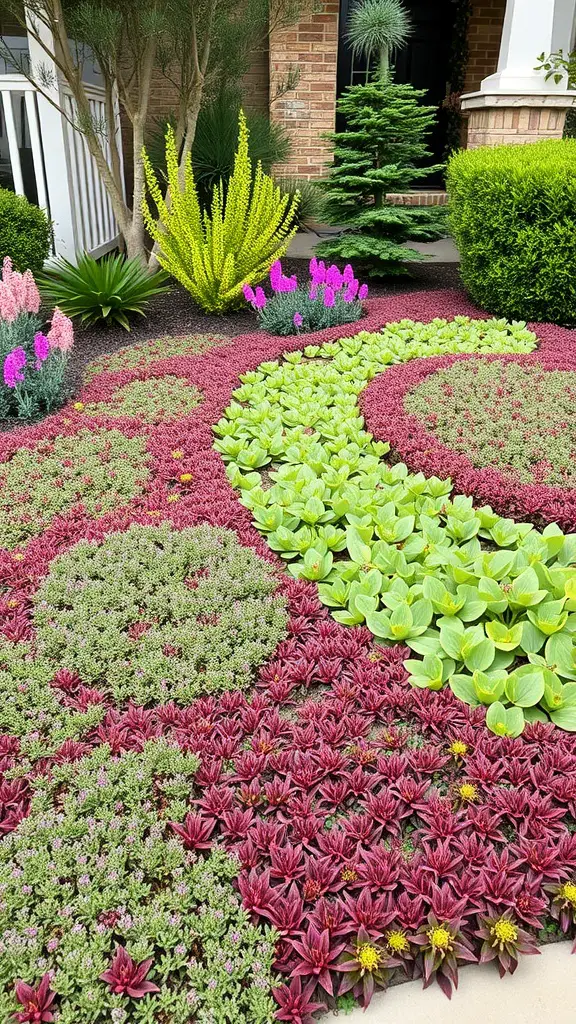
When it comes to desert landscaping, choosing the right ground covers is key. The image showcases a stunning front yard filled with vibrant, drought-resistant plants. These colorful ground covers not only look great but also thrive in dry conditions.
The lush greens and rich reds create a beautiful contrast, making the yard inviting. Plants like sedum and thyme are perfect choices for this type of landscape. They require minimal water and provide excellent ground coverage.
Incorporating various textures and colors can enhance the visual appeal. The winding pattern in the planting design adds a playful touch, guiding the eye through the space. This approach not only conserves water but also creates a lively atmosphere.
Using drought-resistant ground covers is a smart way to maintain a beautiful yard while being mindful of water usage. It’s a win-win for both aesthetics and sustainability!
Functional Outdoor Spaces
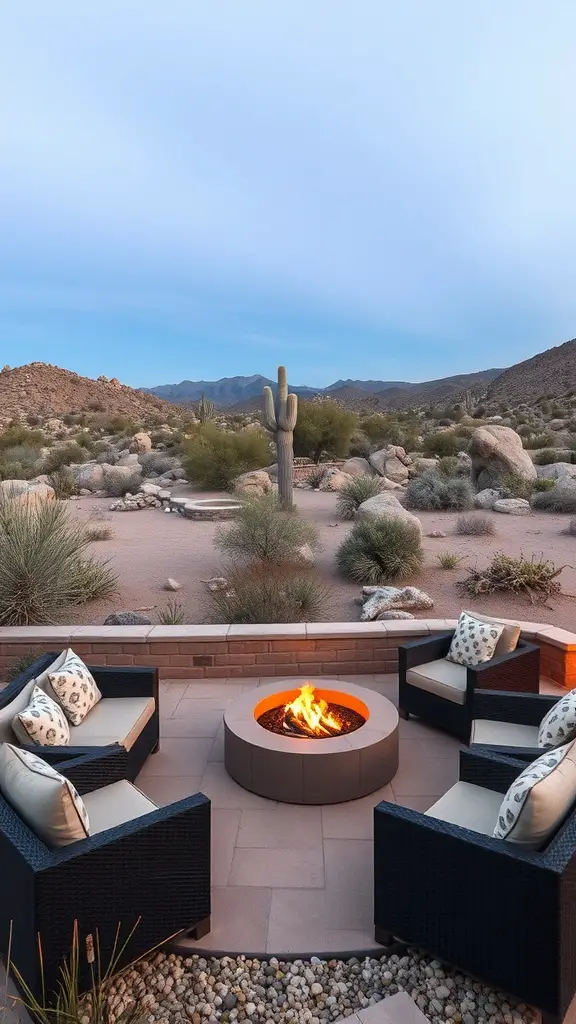
Creating functional outdoor spaces in desert landscaping can be both practical and inviting. The image shows a cozy fire pit area surrounded by comfortable seating. This setup is perfect for gatherings, allowing friends and family to enjoy the warm evenings under the stars.
The fire pit serves as a central feature, drawing people in and providing warmth. It’s a great spot for roasting marshmallows or sharing stories. The surrounding chairs are designed for comfort, making it easy to relax and unwind.
Incorporating natural elements like rocks and desert plants enhances the overall look. These features blend seamlessly with the landscape, creating a harmonious environment. This design not only looks good but also functions well in the desert climate.
Overall, this outdoor space exemplifies how to make the most of your front yard while embracing the beauty of desert landscaping. It’s a perfect example of how to create a welcoming atmosphere that encourages outdoor living.
Creative Use of Sand
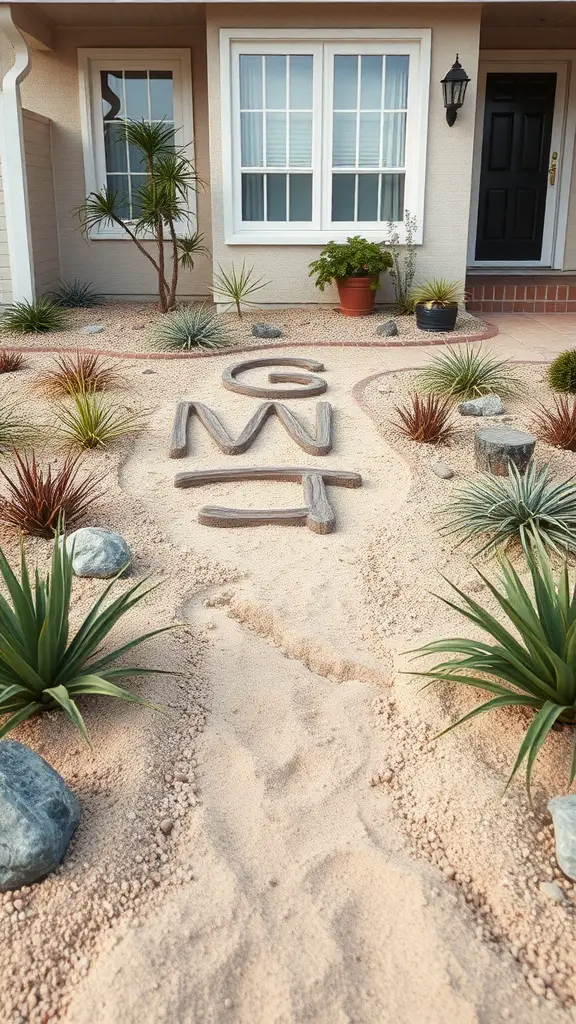
Sand can be a fantastic element in desert landscaping, and this front yard showcases its potential beautifully. The sandy path winds through the yard, creating a natural flow that invites exploration. The use of sand here isn’t just practical; it adds a unique aesthetic that complements the surrounding plants.
The arrangement of rocks and greenery against the soft sand creates a striking contrast. The plants chosen are well-suited for arid conditions, adding texture and color without requiring much water. This thoughtful combination makes the yard both eye-catching and sustainable.
Incorporating sand into your landscaping can also be a fun way to express creativity. The design in the sand adds a personal touch, making the space feel unique. Whether you choose to create patterns or leave it more natural, sand can enhance the overall look of your front yard.
Shade Solutions for Desert Yards
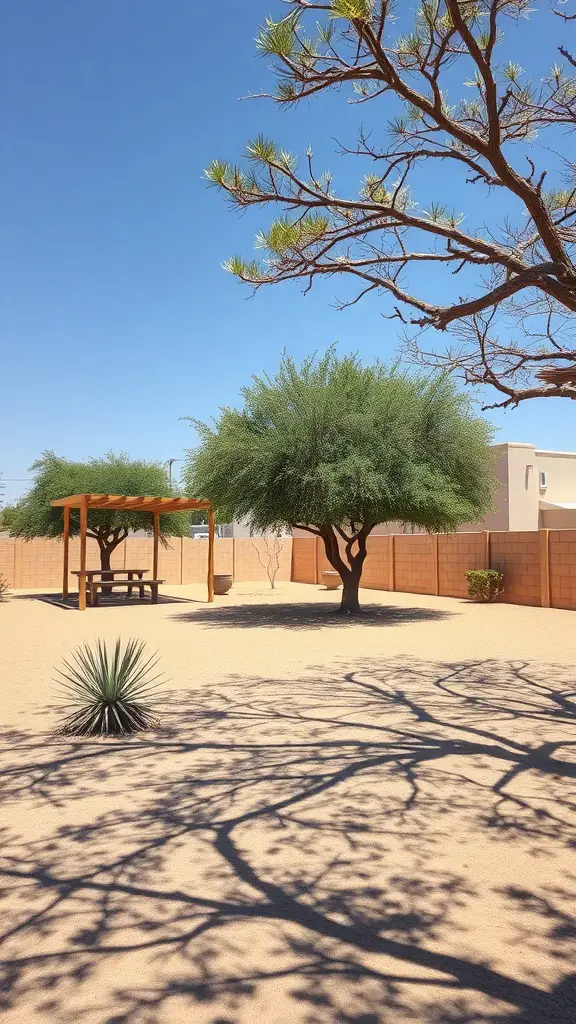
Creating shade in a desert yard is essential for comfort and plant health. The image shows a well-thought-out space with trees and a pergola that provide relief from the sun. The trees cast beautiful shadows on the sandy ground, making the area inviting.
Using native trees like mesquite or palo verde can offer shade while thriving in arid conditions. These trees not only provide cooling shade but also add character to your landscape. The pergola in the image is a great addition, offering a perfect spot for relaxation or outdoor dining.
Incorporating low-maintenance plants like agave can enhance the aesthetic while requiring minimal water. This combination of trees and hardy plants creates a balanced environment, making your desert yard both functional and beautiful.
Wildlife-Friendly Landscaping
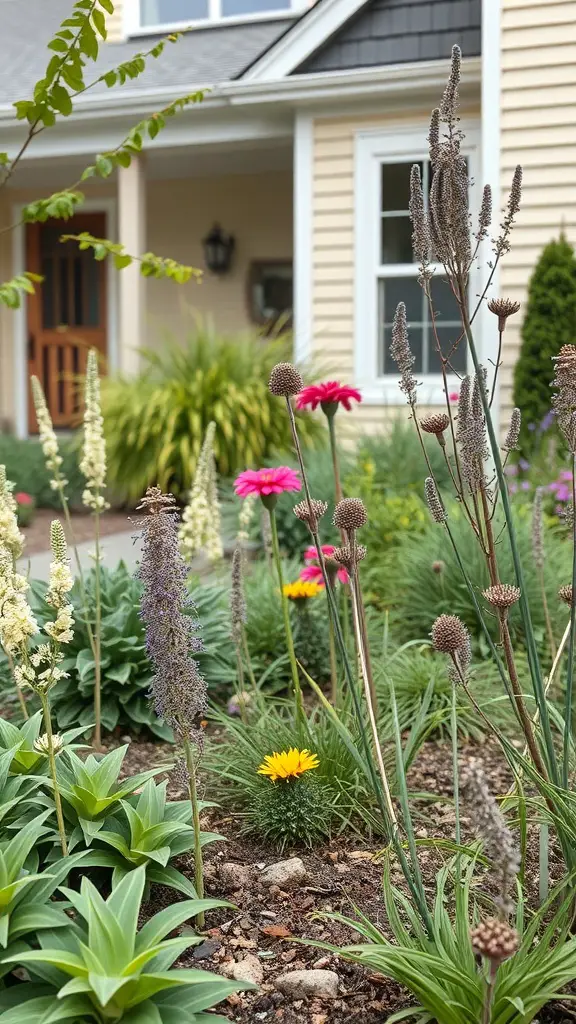
Creating a wildlife-friendly front yard can be both beautiful and beneficial. The image shows a vibrant garden filled with various plants that attract local wildlife. Bright flowers like pink and yellow daisies stand out among lush green foliage, providing a welcoming space for pollinators.
Incorporating native plants is key. These plants are adapted to the local climate and soil, making them easier to care for. They also provide food and shelter for birds, butterflies, and other creatures. The tall, slender flowers in the image are perfect for attracting bees and hummingbirds, adding life to your garden.
Using a mix of textures and heights creates visual interest. The combination of flowering plants and leafy greens not only looks appealing but also supports a diverse ecosystem. This approach encourages beneficial insects and helps maintain a balanced environment.
Consider adding features like birdbaths or small rocks for lizards to bask on. These elements enhance the habitat and make your yard a lively spot for wildlife. A wildlife-friendly garden is a joy to watch and a great way to contribute to local biodiversity.
Water Features in Arid Landscapes
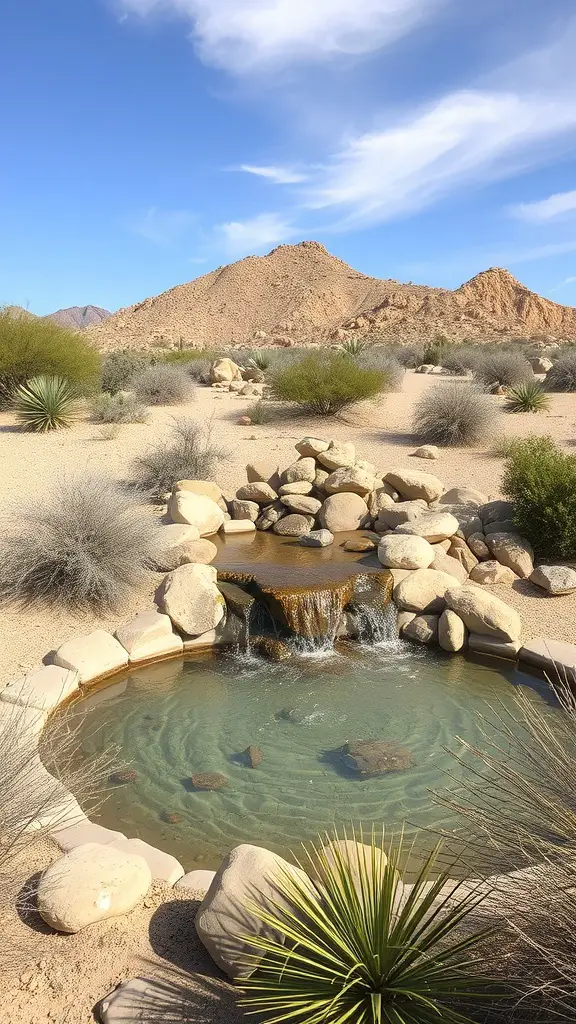
Water features can transform a dry landscape into a refreshing spot. In the image, we see a serene pond surrounded by smooth stones and a gentle waterfall. This setup adds a touch of tranquility to the arid surroundings.
In desert landscaping, water features serve multiple purposes. They not only create a focal point but also attract wildlife. Birds and butterflies are drawn to the water, bringing life to the otherwise dry area.
Choosing the right materials is key. The natural stones in the image blend beautifully with the desert environment. They help the water feature look like a part of the landscape rather than an addition.
Maintenance is also important. Opting for a recirculating pump can keep the water clean and reduce evaporation. This way, you can enjoy the beauty of your water feature without worrying too much about upkeep.
Incorporating plants around the water can enhance the look. Succulents and desert flowers thrive in these conditions and add color. Together, they create a peaceful retreat in your front yard.
Seasonal Color Changes
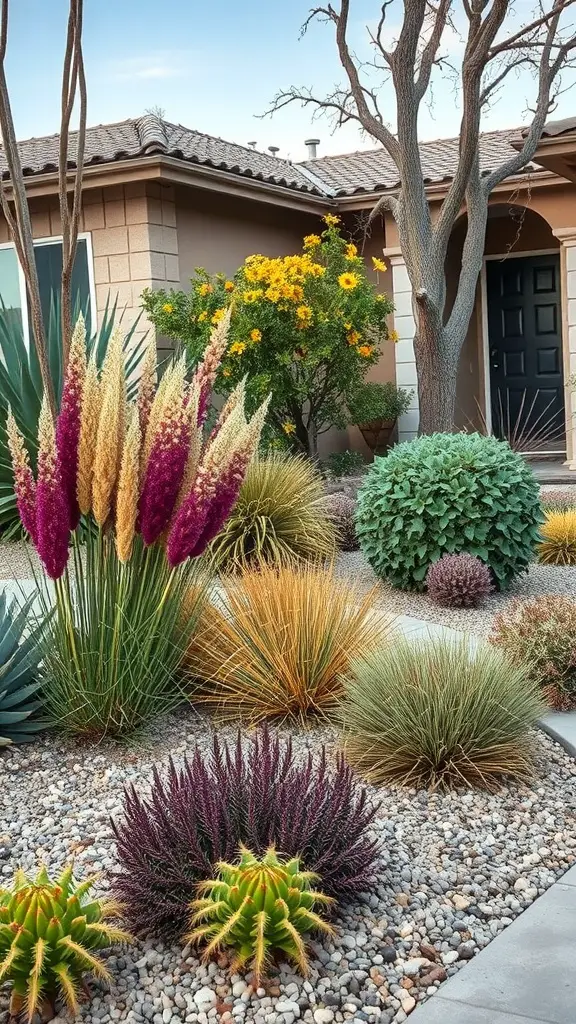
In desert landscaping, seasonal color changes can bring a fresh look to your front yard. The image showcases a vibrant mix of plants that change with the seasons, adding interest and beauty.
Notice the striking purple and gold hues from the plants. These colors pop against the neutral tones of the gravel and the home. As seasons shift, the foliage will transform, offering new shades and textures.
In spring, the yellow blooms from the flowering shrubs create a cheerful atmosphere. Summer brings lush greens and vibrant colors, while autumn introduces warm, earthy tones. Winter may reveal a more subdued palette, but the shapes and forms of the plants still provide visual appeal.
Choosing plants that thrive in your climate ensures that your yard remains lively throughout the year. This thoughtful selection can make your front yard a stunning showcase of nature’s beauty, no matter the season.
Native Plant Integration
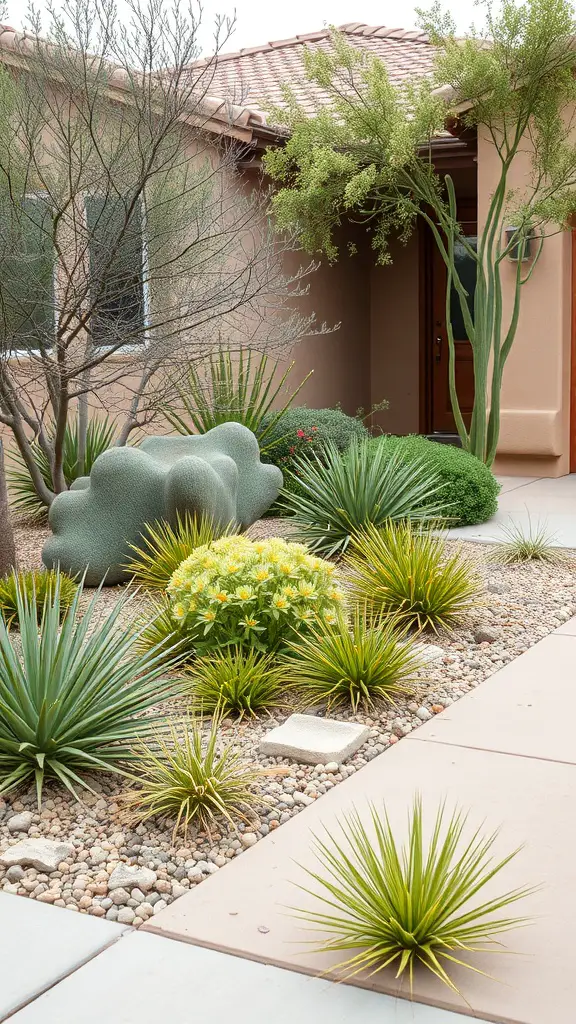
Incorporating native plants into your desert landscaping is a fantastic way to create a beautiful and sustainable front yard. The image showcases a variety of native plants that thrive in arid conditions, making them perfect for this type of environment.
Notice the unique shapes and textures of the plants. The spiky agaves and soft, rounded succulents add visual interest. These plants not only look great, but they also require less water and maintenance compared to non-native species.
Using native plants helps support local wildlife, too. Birds and insects are drawn to these plants, creating a lively ecosystem right in your front yard. This integration of nature enhances the overall appeal of your home while being environmentally friendly.
Consider adding a mix of colors and heights to create a dynamic landscape. The yellow flowers in the image provide a pop of color against the green foliage, making the yard inviting and cheerful.


